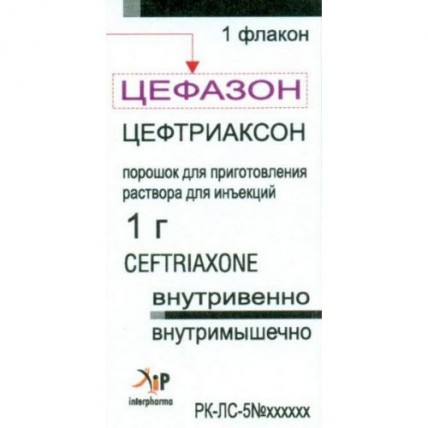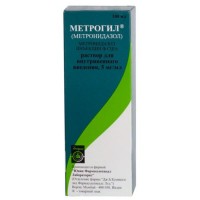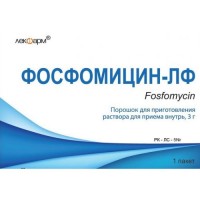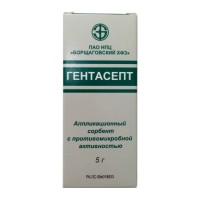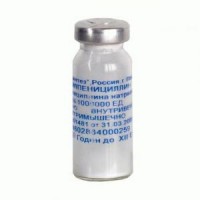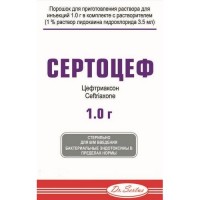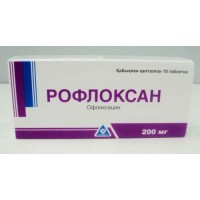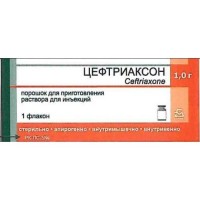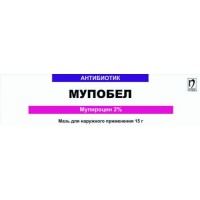Tsefazon 1's 1g powder for solution for injection
- $10.70
The instruction for medical use of Tsefazon Torgovoye medicine a name Tsefazon Mezhdunarodnoye the unlicensed name Tseftriakson Lekarstvennaya a form Powder for preparation of solution for injections of 1 g Structure One bottle contains active agent – a tseftriakson of sodium sterile, the Description Fine-crystalline slightly hygroscopic powder from white till light yellow color is equivalent to a tseftriakson to anhydrous 1 g. Pharmacotherapeutic group Antibacterial drugs of system use. Beta laktamnye antibacterial drugs other. Cephalosporins of the third generation. Tseftriakson the ATX J01DD04 Code the Pharmacological Pharmacokinetics Bioavailability properties – 100%. Time of achievement of the maximum concentration (TCmax) after intramuscular introduction – 2-3 h, after intravenous administration – at the end of infusion. Maximum concentration (Cmax) after intramuscular introduction in a dose of 1 g are made by 76 mkg/ml, after intravenous administration in a dose of 1 g – 151 mkg/ml. At adults in 2-24 h after introduction in a dose of 50 mg/kg of body weight the concentration in cerebrospinal fluid (SMZh) many times over exceeds the minimum overwhelming concentration (MOC) for the most widespread causative agents of meningitis. Well gets into SMZh at inflammation of a meninx. Communication with proteins of plasma – 83-96%. Distribution volume – 0.12-0.14 l/kg (5.78-13.5 l), at children is 0.3 l/kg, plasma clearance – 0.58-1.45 l/h, renal – 0.32-0.73 l/h. Elimination half-life (T ½) after intramuscular introduction makes 5.8-8.7 h, after intravenous administration in a dose of 50-75 mg/kg of body weight at children with meningitis – 4.3-4.6 h, at the patients who are on a hemodialysis (clearance of creatinine (CC) of 0-5 ml/min.) – 14.7 h, at KK of 5-15 ml/min. – 15.7 h, 16-30 ml/min. – 11.4 h, 31-60 ml/min. – 12.4 h. It is removed in not changed look: 33-67% kidneys, 40-50% – with bile in intestines where there is an inactivation. At newborn children through kidneys about 70% of drug are removed. The hemodialysis is not effective. Tsefazon's pharmacodynamics – a tsefalosporinovy antibiotic of the III generation of a broad spectrum of activity for parenteral administration. The bactericidal activity is caused by suppression of synthesis of a cell wall of bacteria. Differs in resistance to action of the majority beta laktamaz gram-negative and gram-positive microorganisms. It is active in the relation of the following microorganisms: gram-positive aerobes – Staphylococcus aureus (including the strains producing penicillinase), Staphylococcus epidermidis, Staphylococcus pneumoniae, Staphylococcus pyogenes, Staphylococcus viridans, gram-negative aerobes: Acinetobacter calcoaceticus, Enterobacter aerogenes, Enterobacter cloacae, Escherichia coli, Haemophilus influenzae (including the strains forming penicillinase), Haemophilus parainfluenzae, Klebsiella spp. (including Klebsiella pneumoniae), Moraxella catarrhalis (including penitsillinprodutsiruyushchy strains), Morganella morganii, Neisseria gonorrhoeae (including the strains forming penicillinase), Neisseria meningitides, Proteus mirabilis, Proteus vulgaris, Serratia spp. (including Serratia marcescens), separate strains of Pseudomonas aeruginosa are also sensitive, anaerobe bacterias: Bacteroides fragilis, Clostridium spp. (except Clostridium difficile), Peptostreptococcus spp. Has activity of in vitro concerning the majority of strains of the following microorganisms though the clinical value of it is unknown: Citrobacter diversus, Citrobacter freundii, Providencia spp., Providencia rettgeri, Salmonella spp., (including Salmonella typhi), Shigella spp., Streptococcus agalactiae, Bacteroides bivius, Bacteroides melaninogenicus. Metitsillinoustoychivye staphylococcus also many strains of streptococci of group D and enterococci, including Enterococcus faecalis are resistant to cephalosporins, including to a tseftriakson, are also resistant to a tseftriakson. The indications of the Infection caused by activators, sensitive to the drug Tsefazon: - sepsis - meningitis - a disseminate disease of Lyme (early and late stages of a disease) - infections of abdominal organs (peritonitis, infections of biliary tract and digestive tract) - infections of bones, joints, soft tissues, skins, wound fevers - infections at patients with the weakened immunity - infections of kidneys and urinary tract - respiratory infections, especially pneumonia, infections of ENT organs - genital infections, including gonorrhea - preoperative prevention of infectious complications. Route of administration and doses Intravenously and intramusculary. To adults and children 12 years are more senior – on 1-2 g of 1 times a day or 0.5-1 g each 12 h, the daily dose should not exceed 4 g. For newborns (up to 2 weeks) – 20-50 mg/kg/days. For babies and children up to 12 years a daily dose – 20-80 mg/kg of body weight. Children with body weight have 50 kg and apply doses to adults above. It is necessary to appoint a dose more than 50 mg/kg of body weight in the form of intravenous infusion within 30 minutes. Tsefazon is contraindicated to newborns (≤8 days) who already appoints or supposes intravenous treatment kaltsiysoderzhashchy solutions, including long kaltsiysoderzhashchy infusions, for example, at parenteral nutrition because of risk of formation of precipitated calcium superphosphates of calcic salts of a tseftriakson. Patients of advanced and senile age Usual doses for adults, without adjustments for age. Duration of treatment depends on a course of the disease. As well as always at antibiotic treatment, administration of the drug Tsefazon should be continued the patient within at least 48-72 hours after normalization of temperature and confirmation of an eradikation of the activator. Combination therapy synergism between the drug Tsefazon and aminoglycosides concerning many gram-negative bacteria Is shown. In spite of the fact that the increased efficiency of such combinations is not always predictable, it should be meant in heavy, life-threatening infections, such as the caused Pseudomonas aeruginosa. Because of physical incompatibility of a tseftriakson and aminoglycosides they should be entered separately in the doses recommended for them. Meningitis In bacterial meningitis at babies and children of younger age treatment begin with a dose 100 mg/kg (but no more than 4 g) 1 time a day. After identification of the activator and determination of its sensitivity the dose can be reduced respectively. The best results in a spotted fever were achieved lasting treatment of 4 days, in the meningitis caused by Haemophilus influenzae - 6 days, Streptococcus pneumoniae - 7 days. Lyme's disease of 50 mg/kg (the highest daily dose - 2 g) to adults and children once a day within 14 days. The gonorrhea (caused penitsillinazoobrazuyushchy and penitsillinazo - not forming strains) Single intramuscular introduction of 250 mg of the drug Tsefazon. Prevention of postoperative infections Depending on degree of infectious risk is entered by 1-2 g of drug once in 30-90 min. prior to operation. At operations on thick and a rectum well proved simultaneous administration of the drug Tsefazon and one of 5 nitroimidazoles, for example, of an ornidazol. Introduction by the General rule has to be use of solutions right after preparation. The prepared solutions keep the physical and chemical stability within 6 hours at the room temperature (or within 24 hours at a temperature of 2-8 ºC). Depending on concentration and duration of storage color of solutions can vary from pale yellow to amber. Coloring of solution does not affect efficiency or tolerance of drug. For an intramuscular injection of 500 mg of the drug Tsefazon dissolve in 2 ml, and 1 g - in 3.5 ml of 1% of solution of lidocaine and enter deeply into rather big muscle (buttock). It is recommended to enter no more than 1 g into the same muscle. Before intramuscular introduction of a tseftriakson when as solvent lidocaine is used, it is necessary to consider contraindications for lidocaine (see information in the instruction for medical use of medicine lidocaine). The solution containing lidocaine cannot be entered intravenously. Lidocaine is forbidden as solvent at children's and teenage age! Solutions of the drug Tsefazon cannot be mixed or added to the solutions containing other antimicrobial drugs or other solvents because of possible incompatibility. Side effects Side reactions are listed according to a class of a system of bodies and frequency of their manifestation. Categories are determined by frequency as follows: very often (& gt, 1/10), it is frequent (from & gt, 1/100 to & lt, 1/10), infrequently (from & gt, 1/1000 to & lt, 1/100), is rare (from & gt, 1/10,000 to & lt, 1/1000), is very rare (& lt, 1/10,000) and it is unknown (frequency cannot be determined). In each category the side reactions are provided in decreasing order of gravity degree. Often - stomatitis, a glossitis, nausea, vomiting, a meteorism, a liquid chair, diarrhea Infrequently - disturbance of taste - makulopapulezny rash, a dieback, an itching, dermatitis, a small tortoiseshell, hypostases, a polymorphic exudative erythema Seldom - increase in activity of "hepatic" transaminases and alkaline phosphatase, a hyperbilirubinemia, hepatitis, jaundice - precipitation of calcic salts in a gall bladder - an eosinophilia, a leukopenia, a neutropenia, a granulocytopenia, anemia, hemolytic anemia, thrombocytopenia, a thrombocytosis, a leukocytosis, lengthening of a tromboplastinovy and prothrombin time - a headache, dizziness, spasms - anaphylactoid and anaphylactic reactions - phlebitis, pain in the place of an intravenous injection - superinfections, including mycoses of a genital tract - an oliguria, increase in creatinine of serum, a glucosuria, a hamaturia - fever, a fever - an allergic pneumonitis, a bronchospasm - inflows, heartbeat, the increased sweating is Very rare - pseudomembranous colitis, generally caused Clostridium difficile, pancreatitis - an erythema, Stephens-Johnson's syndrome, a Lyell's disease (toxic epidermal necrolysis) - an agranulocytosis, disturbance of blood clotting - an anury, a renal failure, acute tubular necrosis - adjournment of tseftriakson-calcium in kidneys - positive reaction of Koombs With an unknown frequency - immune hemolytic anemia - hemolysis with a fatal outcome Interaction with calcium ions separate fatal cases of formation of precipitated calcium superphosphates in lungs and kidneys by results of an autopsy research at the newborns receiving tseftriakson and kaltsiysoderzhashchy solutions Are described. At the same time one venous access was in some cases used, and formation of precipitated calcium superphosphates was observed directly in a system for intravenous administration. At least, one case from the death is also described, at various venous accesses and to various time of introduction of a tseftriakson and kaltsiysoderzhashchy solutions. At the same time by results of an autopsy research precipitated calcium superphosphates were not found in this newborn. Similar cases were observed only at newborns. It was reported about sporadic cases of an agranulocytosis (& lt, 500/ml), the most part from them was observed after 10 days of treatment and against the background of purpose of total doses more than 20 g. It was reported about sporadic cases of serious reactions (multiformny erythema, Stephens-Johnson's syndrome, a toxic epidermal necrolysis (Lyell's disease)). Very exceptional cases of pseudomembranous colitis are described (& lt, 0.01%) and in kidneys, mainly, at children 3 years which were receiving or high daily doses of drug (more than 80 mg/kg a day), or cumulative doses more than 10 g and also having accessory factors of risk (liquid consumption restriction, a bed rest, etc.) are more senior than disturbances of blood clotting and also formation of concrements. Formation of concrements in kidneys can proceed asymptomatically or clinically be shown, can lead to a renal failure. This undesirable phenomenon has reversible character and disappears after the therapy termination tseftriaksony. In rare instances at treatment tseftriaksony at patients false positive results of test of Koombs can be noted. As well as other antibiotics, Tsefazon can yield false positive result of test on a galactosemia. False positive results can be received also when determining glucose in urine by not fermental methods therefore during therapy tseftriaksony the glucosuria if necessary needs to be determined only by a fermental method. At emergence of any undesirable effect, including undescribed in the instruction, it is necessary to see a doctor. Contraindications - hypersensitivity to cephalosporins and penicillin - hypersensitivity to solvent – lidocaine - heavy reactions of hypersensitivity (for example, anaphylactic reactions) on any other type beta laktamnykh antibacterial drugs (penicillin, monobaktama, karbapenema) in the anamnesis - a hyperbilirubinemia at newborn and premature (tseftriakson can force out bilirubin from communication with seralbumin, increasing risk of developing bilirubinovy encephalopathy at such patients) - premature newborns up to 41 weeks (week of pregnancy + weeks of life) - newborns (≤28 days) which already appoints or supposes intravenous treatment kaltsiysoderzhashchy solutions including long kaltsiysoderzhashchy infusions, for example, at parenteral nutrition, because of risk of formation of precipitated calcium superphosphates of calcic salts of a tseftriakson - the I trimester of pregnancy - the solutions containing lidocaine it is forbidden to enter intravenously - lidocaine as solvent is contraindicated at children's and teenage age Medicinal interactions It is impossible to mix Tsefazon rolled into one or the syringe with other antibiotic. Tseftriakson and aminoglycosides show synergism concerning gram-negative bacteria (it is especially proved their joint use in heavy and life-threatening infections). Tseftriakson, suppressing indestinal flora, interferes with vitamin K synthesis. Therefore at simultaneous use with the drugs reducing aggregation of thrombocytes (NPVS, salicylates, Sulfinpyrazonum) the risk of developing bleedings increases. For the same reason at simultaneous use with anticoagulants strengthening of anticoagulating action is noted. At simultaneous use with loopback diuretics the risk of development of nephrotoxic action increases. The incompatibility Tsefazon should not be added to infusion solutions, calciferous, for example, Hartman and Ringer's solution. Tseftriakson is incompatible and should not mix up with amsakriny, Vancomycinum, flukonazoly and aminoglycosides. Influence on results of laboratory analyses In rare instances at treatment by Tsefazon at patients false positive results of test of Koombs can be noted. As well as other antibiotics, Tsefazon can yield false positive result of test on a galactosemia. False positive results can be received also when determining glucose in urine therefore during therapy by Tsefazon the glucosuria if necessary needs to be determined only by a fermental method. Special instructions As well as at use of other cephalosporins, were registered anaphylactic reactions, including from the death, even in cases when the patient had no allergic reactions in the anamnesis. As well as at use of other cephalosporins, at the Tsefazon drug treatment the development of autoimmune hemolytic anemia is possible. Cases of heavy hemolytic anemia at adults and children, including from the death are registered. At development in the patient who is on treatment tseftriaksony the anemia cannot exclude the diagnosis cephalosporin - the associated anemia and it is necessary to cancel treatment before clarification of the reason. As well as at use of the majority of other antibacterial drugs, at treatment tseftriaksony cases of development of the diarrhea caused by Clostridium difficile are registered (C. difficile), various weight: from slight diarrhea to colitis from the death. Treatment by antibacterial drugs suppresses normal microflora of a large intestine and provokes growth of C. difficile. In turn, C. difficile forms toxins A and B which are factors of pathogenesis of the diarrhea caused by C. difficile. S.'s strains of difficile which are hyper producing toxins are causative agents of infections with high risk of complications and mortality, owing to their possible resistance to antimicrobic therapy, treatment can demand colectomy. It is necessary to remember a possibility of development of the diarrhea caused by C. difficile at all patients with diarrhea after antibiotic treatment.
Ny collecting the anamnesis since cases of developing of the diarrhea caused by C. difficile later after therapy are noted more than 2 months by antibiotics is necessary for a tshchata. At suspicion or confirmation of the diarrhea caused by C. difficile the cancellation of the current antibiotic treatment difficile which is not directed to S. perhaps will be required. According to clinical indications the corresponding treatment with input of the fluid and electrolytes, proteins, antibiotic treatment concerning S. difficile, surgical treatment has to be appointed. As well as at treatment by other antibacterial drugs, superinfections can develop. At the patients receiving Tsefazon exceptional cases of change of a prothrombin time are described. Control of a prothrombin time can be required by patients with insufficiency of vitamin K (synthesis disturbance, disturbance of food) during therapy and prescribing of vitamin K (10 mg/week) at increase in a prothrombin time prior to the beginning of or during therapy. After use of a tseftriakson, usually in the doses exceeding standard recommended, at ultrasound examination of a gall bladder, shadows which mistakenly took for stones came to light. They represent precipitated calcium superphosphates of calcic salt of a tseftriakson which disappear after end or the termination of therapy by the drug Tsefazon. Similar changes seldom give any symptomatology, but also in such cases only the conservative treatment is recommended. If these phenomena are followed by clinical symptomatology, then the decision on drug withdrawal is left to the discretion of the attending physician. At the patients receiving Tsefazon exceptional cases of the pancreatitis developing perhaps, owing to obstruction of bilious ways are described. Most of these patients had risk factors of stagnation in bilious ways, for example, earlier carried out therapy, a serious illness and completely parenteral nutrition already before. At the same time it is impossible to exclude a starting role, formed under the influence of the drug Tsefazon, precipitated calcium superphosphates in bilious ways in development of pancreatitis. At use of a tseftriakson, cases of the nephrolithiasis passing after drug withdrawal are described. At emergence of clinical symptomatology the ultrasound examination of kidneys is shown. The decision on prescribing of the drug Tsefazon to patients with a nephrolithiasis or a hyperuricemia in the anamnesis has to be accepted by the attending physician after assessment "advantage/risk". Despite availability of data on formation of intravascular precipitated calcium superphosphates only at newborns at use of a tseftriakson and kaltsiysoderzhashchy infusion solutions or any other kaltsiysoderzhashchy drugs, Tsefazon should not mix or appoint children and adult patients along with kaltsiysoderzhashchy infusion solutions, even using various venous accesses. Safety and efficiency of the drug Tsefazon at newborns, babies and children of younger age were defined for the dosages described in the section "Route of Administration and Doses". Researches showed what like other cephalosporins tseftriakson can force out bilirubin from communication with seralbumin. Tsefazon it is impossible to apply at newborns, especially premature which have a risk of developing bilirubinovy encephalopathy. At long-term treatment it is necessary to carry out complete analysis of blood regularly. In a heavy renal and liver failure, clinical control of safety and efficiency of drug is necessary. Pregnancy and a lactation Adequate and strictly controlled researches of safety of a tseftriakson at pregnancy were not conducted. It is impossible to use drug in II and III trimesters of pregnancy if to it there are no absolute indications. Tseftriakson gets through a placental barrier. In need of use of drug in the period of a lactation it is necessary to stop breastfeeding for the period of treatment. In small concentration tseftriakson it is allocated with breast milk. There Is no feature of influence of medicine on ability to run the vehicle any data indicating ability of a tseftriakson to influence somehow driving or other vehicle. Overdose Symptoms: rash, urticaria, fever, a fever, a headache, dizziness, the increased sweating, nausea, vomiting, confusion of consciousness and a spasm. Specific antidote does not exist. Treatment: excessively high concentrations of a tseftriakson in plasma cannot be lowered by means of a hemodialysis. For treatment of cases of overdose symptomatic measures are recommended. The form of release and packing On 1 g of drug (in terms of tseftriakson anhydrous) place in the bottles of colourless glass corked by rubber bungs and which are pressed out by aluminum caps with plastic nakolpachnik. On a bottle paste the self-adhesive paper label. On 1 bottle together with the instruction for medical use in the state and Russian languages place in a cardboard box. To Store storage conditions in the dry, protected from light place at a temperature not above 25 °C. The restored solution is stable during 6 h at a temperature not higher than 25 wasps or during 24 h at a temperature from 2 wasps up to 8 wasps. To store out of children's reach! 2 years not to apply a period of storage after the expiration date specified on packing Prescription status According to the prescription Swiss Parenterals Pvt Producer. Ltd., India 402, 412-414, Kerala Industrial Estate, Nr. Bavla, Dist. Ahmedabad – 382,220 Gujarat, India the Owner of the registration certificate of Inter Pharma, India
to Develop the Address of the organization accepting in the territory of the Republic of Kazakhstan claims from consumers on quality of medicines and responsible for post-registration observation of safety of medicine of KazEvroFarm LLP 050000, Republic of Kazakhstan, Almaty, Kurmangaza St., 48a, office 9
Ny collecting the anamnesis since cases of developing of the diarrhea caused by C. difficile later after therapy are noted more than 2 months by antibiotics is necessary for a tshchata. At suspicion or confirmation of the diarrhea caused by C. difficile the cancellation of the current antibiotic treatment difficile which is not directed to S. perhaps will be required. According to clinical indications the corresponding treatment with input of the fluid and electrolytes, proteins, antibiotic treatment concerning S. difficile, surgical treatment has to be appointed. As well as at treatment by other antibacterial drugs, superinfections can develop. At the patients receiving Tsefazon exceptional cases of change of a prothrombin time are described. Control of a prothrombin time can be required by patients with insufficiency of vitamin K (synthesis disturbance, disturbance of food) during therapy and prescribing of vitamin K (10 mg/week) at increase in a prothrombin time prior to the beginning of or during therapy. After use of a tseftriakson, usually in the doses exceeding standard recommended, at ultrasound examination of a gall bladder, shadows which mistakenly took for stones came to light. They represent precipitated calcium superphosphates of calcic salt of a tseftriakson which disappear after end or the termination of therapy by the drug Tsefazon. Similar changes seldom give any symptomatology, but also in such cases only the conservative treatment is recommended. If these phenomena are followed by clinical symptomatology, then the decision on drug withdrawal is left to the discretion of the attending physician. At the patients receiving Tsefazon exceptional cases of the pancreatitis developing perhaps, owing to obstruction of bilious ways are described. Most of these patients had risk factors of stagnation in bilious ways, for example, earlier carried out therapy, a serious illness and completely parenteral nutrition already before. At the same time it is impossible to exclude a starting role, formed under the influence of the drug Tsefazon, precipitated calcium superphosphates in bilious ways in development of pancreatitis. At use of a tseftriakson, cases of the nephrolithiasis passing after drug withdrawal are described. At emergence of clinical symptomatology the ultrasound examination of kidneys is shown. The decision on prescribing of the drug Tsefazon to patients with a nephrolithiasis or a hyperuricemia in the anamnesis has to be accepted by the attending physician after assessment "advantage/risk". Despite availability of data on formation of intravascular precipitated calcium superphosphates only at newborns at use of a tseftriakson and kaltsiysoderzhashchy infusion solutions or any other kaltsiysoderzhashchy drugs, Tsefazon should not mix or appoint children and adult patients along with kaltsiysoderzhashchy infusion solutions, even using various venous accesses. Safety and efficiency of the drug Tsefazon at newborns, babies and children of younger age were defined for the dosages described in the section "Route of Administration and Doses". Researches showed what like other cephalosporins tseftriakson can force out bilirubin from communication with seralbumin. Tsefazon it is impossible to apply at newborns, especially premature which have a risk of developing bilirubinovy encephalopathy. At long-term treatment it is necessary to carry out complete analysis of blood regularly. In a heavy renal and liver failure, clinical control of safety and efficiency of drug is necessary. Pregnancy and a lactation Adequate and strictly controlled researches of safety of a tseftriakson at pregnancy were not conducted. It is impossible to use drug in II and III trimesters of pregnancy if to it there are no absolute indications. Tseftriakson gets through a placental barrier. In need of use of drug in the period of a lactation it is necessary to stop breastfeeding for the period of treatment. In small concentration tseftriakson it is allocated with breast milk. There Is no feature of influence of medicine on ability to run the vehicle any data indicating ability of a tseftriakson to influence somehow driving or other vehicle. Overdose Symptoms: rash, urticaria, fever, a fever, a headache, dizziness, the increased sweating, nausea, vomiting, confusion of consciousness and a spasm. Specific antidote does not exist. Treatment: excessively high concentrations of a tseftriakson in plasma cannot be lowered by means of a hemodialysis. For treatment of cases of overdose symptomatic measures are recommended. The form of release and packing On 1 g of drug (in terms of tseftriakson anhydrous) place in the bottles of colourless glass corked by rubber bungs and which are pressed out by aluminum caps with plastic nakolpachnik. On a bottle paste the self-adhesive paper label. On 1 bottle together with the instruction for medical use in the state and Russian languages place in a cardboard box. To Store storage conditions in the dry, protected from light place at a temperature not above 25 °C. The restored solution is stable during 6 h at a temperature not higher than 25 wasps or during 24 h at a temperature from 2 wasps up to 8 wasps. To store out of children's reach! 2 years not to apply a period of storage after the expiration date specified on packing Prescription status According to the prescription Swiss Parenterals Pvt Producer. Ltd., India 402, 412-414, Kerala Industrial Estate, Nr. Bavla, Dist. Ahmedabad – 382,220 Gujarat, India the Owner of the registration certificate of Inter Pharma, India
to Develop the Address of the organization accepting in the territory of the Republic of Kazakhstan claims from consumers on quality of medicines and responsible for post-registration observation of safety of medicine of KazEvroFarm LLP 050000, Republic of Kazakhstan, Almaty, Kurmangaza St., 48a, office 9
